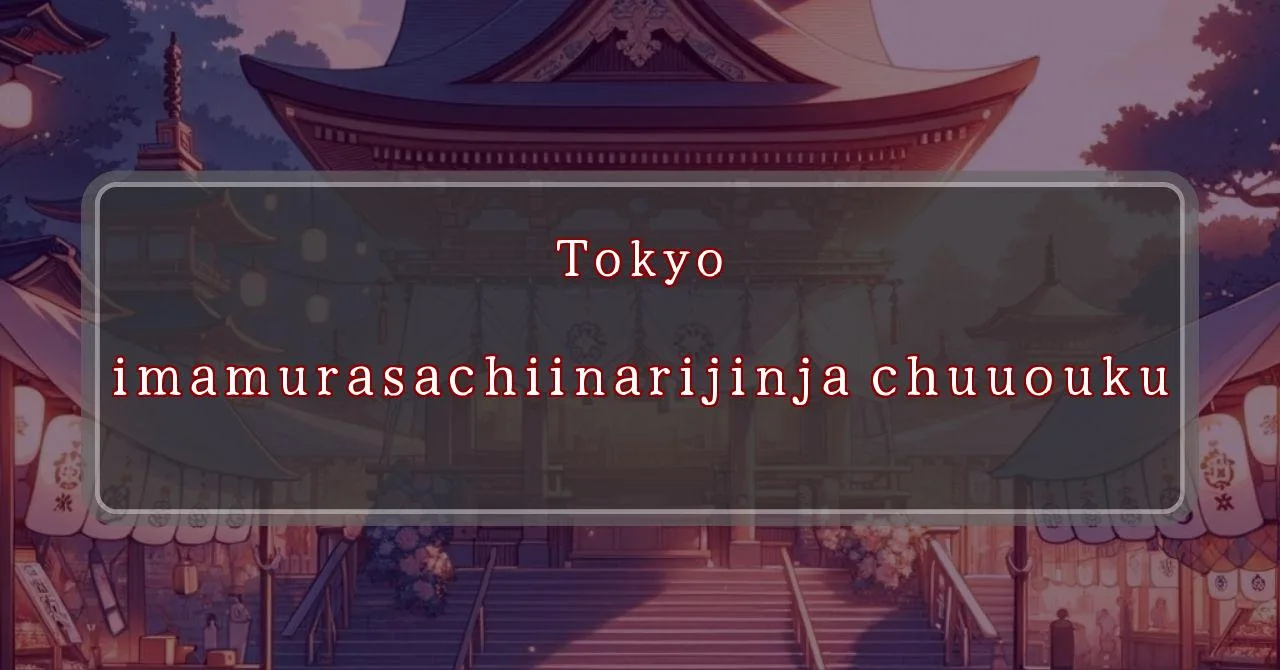Vibrant hues dance at Tokyo’s hidden gem
Basic Information
Nestled in the heart of Tokyo’s Chuo Ward, the sacred 今村幸稲荷神社 stands as a testament to the city’s rich cultural heritage. While its exact origins remain shrouded in mystery, the shrine is believed to have existed since the early Edo period, with its current structure dating back to 1969.
- Address: 3-24-11 Hatchobori, Chuo-ku, Tokyo
- Phone Number: N/A
- Access: A short 2-minute walk from Hatchobori Station, served by both the JR Keiyo Line and Tokyo Metro Hibiya Line.
- Festival Days: N/A
Main Events and Attractions of the Festival
While the 今村幸稲荷神社 does not hold a designated annual festival, it remains a significant site for spiritual and cultural practices throughout the year.
Prayer and Worship
Devotees visit the shrine to offer prayers and seek blessings from the enshrined deity, 宇気母智神 (Ukemochi no Kami), the Shinto deity of food, agriculture, and industry. Worshippers express their gratitude for past blessings and pray for continued prosperity, good health, and success in their endeavors.
Seasonal Events and Ceremonies
The shrine observes various seasonal events and ceremonies in accordance with the Shinto calendar. These events include:
- Setsubun (Early February): A purification ritual to mark the beginning of spring, featuring the traditional scattering of roasted soybeans to ward off evil spirits and bring good fortune.
- Hina Matsuri (March 3rd): Also known as the Doll Festival, this event celebrates the health and happiness of young girls. Families display elaborate doll arrangements in their homes and visit shrines to pray for their daughters’ well-being.
- Shichi-Go-San (November 15th): A rite of passage ceremony for children aged three, five, and seven, marking their growth and transition to new stages of life. Children visit the shrine dressed in traditional kimono to receive blessings and pray for their continued health and happiness.
Cultural and Community Events
The shrine also hosts occasional cultural and community events, such as:
- Traditional Dance and Music Performances: The shrine invites local performing arts groups to showcase their talents, preserving and promoting Japanese cultural traditions.
- Exhibitions and Workshops: The shrine may organize exhibitions showcasing historical artifacts, local crafts, or traditional arts. Workshops are also held, providing opportunities for visitors to learn about and engage with Japanese culture firsthand.
- Community Gatherings and Festivals: The shrine serves as a gathering place for local residents to celebrate festivals and events together, fostering a sense of community and belonging.
Blessings and Deities
The 今村幸稲荷神社 is dedicated to the deity 宇気母智神 (Ukemochi no Kami), also known as 倉稲魂命 (Ukanomitama no Mikoto). This deity is revered as the Shinto god of food, agriculture, and industry, embodying the concept of nourishment and sustenance. Worshippers pray to Ukemochi no Kami for blessings related to:
- Prosperous harvests and bountiful crops
- Success in business and financial endeavors
- Good health and well-being
- Protection against famine and natural disasters
Origin and History
The exact origins of the 今村幸稲荷神社 are shrouded in mystery, with no precise records of its establishment. However, it is believed to have existed since the early Edo period (1603-1868), with its current structure dating back to 1969. The shrine’s name, “今村幸稲荷神社,” is derived from its location in the former “幸町” (Saiwai-cho) district and the presence of an Inari shrine. Inari shrines are commonly found throughout Japan and are dedicated to Inari Ōkami, the Shinto deity of rice and fertility.
Tips and Notes for Visitors
If you plan to visit the 今村幸稲荷神社, here are a few tips and notes to keep in mind:
- Location and Access: The shrine is situated in the Chuo Ward of Tokyo, a short walk from the Hatchobori Station served by the JR Keiyo Line and Tokyo Metro Hibiya Line.
- Hours and Admission: The shrine is generally open to the public during daylight hours, with no admission fee required.
- Respectful Attire: While there is no strict dress code, visitors are encouraged to dress respectfully when visiting the shrine. This may include avoiding overly casual or revealing clothing.
- Offerings and Donations: Visitors can make offerings of money or other symbolic items at the shrine’s offertory box. Donations are used to maintain the shrine and support its activities.
- Photography: Photography is generally permitted within the shrine grounds, but it is important to be respectful of other visitors and avoid taking photos during ceremonies or rituals.
Parking Information
Unfortunately, the 今村幸稲荷神社 does not have its own dedicated parking lot. However, there are several public parking facilities and coin-operated parking lots in the surrounding area. Visitors are advised to use public transportation or consider nearby parking options when planning their visit.
Popular Stalls and Food Carts in Recent Years
| Type of Stall | Description |
|---|---|
| Takoyaki | A staple at Japanese festivals. Characterized by a crispy outside and a creamy inside. |
| Jaga Butter | A simple yet popular snack of hot potatoes lavishly topped with melted butter. |
| Baby Castella | Small castella cakes, sweet and fluffy treats enjoyed by children and adults alike. |
| Grilled Ayu with Salt | Fresh ayu fish grilled whole with salt, a savory taste of Japanese summer. |
| Shaapin | A unique gourmet item influenced by foreign cuisine, with a chewy skin wrapping the filling. |
| Okonomiyaki | A Japanese grilled dish where you often choose your own ingredients for a personalized flavor. |
| Cotton Candy | A fluffy, sweet snack that’s extremely popular with children. |
| Chocolate Banana | A banana coated in chocolate, a fun and visually appealing dessert. |
| Kushiyaki | Various types of ingredients skewered and grilled, an easy-to-enjoy snack. |
| Yakisoba | Fried noodles mixed with a special sauce, a fast food favorite in Japan. |



